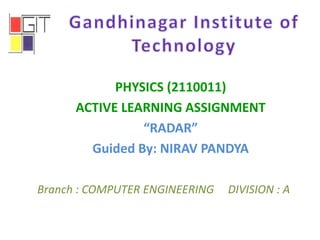Radar
- 1. PHYSICS (2110011) ACTIVE LEARNING ASSIGNMENT âRADARâ Guided By: NIRAV PANDYA Branch : COMPUTER ENGINEERING DIVISION : A
- 2. GROUP Name Enrollment No Jesani Mohsin 130120107035
- 4. âĒRadar is an object detection system which uses radio waves to determine the range, altitude, direction, or speed of objects. âĒIt can be used to detect aircraft, ships, spacecraft, guided missiles, motor vehicles, weather informations, and terrain.
- 5. âĒRadar was secretly developed by several nations before and during World War II. âĒAs early as 1886, German physicist Heinrich Hertz showed that radio waves could be reflected from solid objects. âĒBy using these the German inventor Christian Hulsmeyer was the first to use radio waves to detect the presence of distant metallic objects. âĒBefore the Second World War, researchers in France, Germany, Italy, Japan, the Netherlands, the Soviet Union, the United Kingdom, and the United States, independently and in great secrecy, developed technologies that led to the modern version of radar.
- 6. âĒThe basic idea behind radar is very simple: a signal is transmitted, it bounces off an object and it is later received by some type of receiver. This is like the type of thing that happens when sound echo's off a wall.
- 7. âĒA basic radar system is spilt up into a transmitter, switch, antenna, receiver, data recorder, processor and some sort of output display. âĒEverything starts with the transmitter as it transmits a high power pulse to a switch which then directs the pulse to be transmitted out an antenna. âĒThe radar signals that are reflected back towards the transmitter and are received by the receiver. âĒTime taken by the wave to reach the receiver is measured and then all this information is processed to determine the distance of the object. âĒAnd at last the processed information is displayed in some sort of output display like monitor.
- 8. âĒTo determine the range of a distant object that reflected a radar signal, the receiver must record the time when the signal was received and compare it to when that signal was transmitted. This time is the time taken for the radio wave to propagate to the object and back to the antenna. âĒA simple equation is used to determine the distance. That is V=d/t Thus d=V*t NOTE : Here the final result should be divided by 2 as wave travels double distance. Once when it is transmitted and second when it is strike the antenna. âĒAlso by using this formula we can measure speed if we know distance and time.
- 9. âĒRadar is something that is in use all around us, although it is normally invisible. âĒAir traffic control uses radar to track planes both on the ground and in the air, and also to guide planes in for smooth landings. âĒPolice use radar to detect the speed of passing motorists. âĒThe military uses it to detect the enemy and to guide weapons. âĒMeteorologists use radar to track storms, hurricanes and tornadoes. âĒYou even see a form of radar at many grocery stores when the doors open automatically! Obviously, radar is an extremely useful technology.










